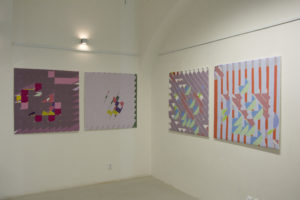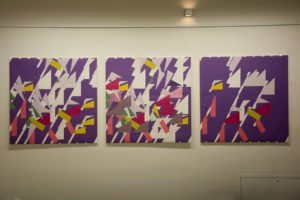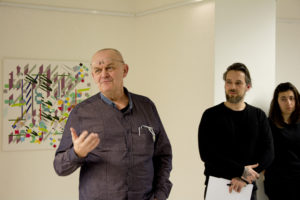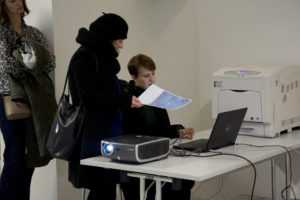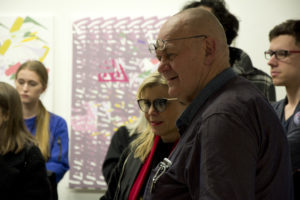IMAGESTRUCTURE / Jaroslav Vančát
Beginning his career in the 1960’s, Vito Acconci’s (1940 – 2017) approach to poetry was spatial. He described the blank page as a space for action that changes irreversibly with the introduction of the first word. The continuously complexifying spatial and conceptual dynamics intensify each time the poet ads a word or punctuation. While none of them can be divorced from a set of connotations of their own, their relational situation is identified by interconnectivity and hyper-complexity. According to Acconci the daedal and analogue process of spatial writing inspired a then up-and-coming generation of artists engaged in computational creativity. Crowning the zeitgeist of technological optimism of that decade, the London-based exhibitions “Ideographs” (1962, Reid Gallery) and “Cybernetic Serendipity” (1968, ICA) revolutionized the art world. Alongside the drawing machines by Desmond Paul Henry, the displays included pioneering works of algorithm art, cybernetic sculptures, early artificial intelligence machines that could write poetry, computer graphics produced through oscilloscopes, works of biomorphism and behavior-based robotics. In this first generation of computer art, programmers became artists and artists became programmers to experiment with the computer’s creative possibilities. Among these revolutionaries was the Czechoslovak artist Zdeněk Sýkora (1920 – 2011). Throughout his life and career Sýkora was dedicated to the exploration of what he described as the “method of controlled randomness”. Traditionally, in the process of art making decisions arise from combined emotional and rational human sources; taste, experience, control, impulse, experimentation, self-challenge, self-imposed rules, order, trance (…). In 1964 in collaboration with mathematician Jaroslav Blažek, Sýkora introduced the computer as his prefered conductor for leading the idea to the image. Here, he intended to exhaust all possible combinations of relative positions of pictorial elements according to computer-programmed rules that go beyond the visionary capacity of the human brain. “I am standing in an open field; all directions are open; the light and wind are coming in from all sides,” the artist once said in an interview; metaphorically refering to how (his) art is not confined by the edge of the painting, but continues in all directions. Zdeněk Sýkora’s for that time highly remarkable approach to painting corresponds to Vito Acconci’s spatial poetry.
Artist and theoretician Jaroslav Vančát (1949) was a student of Zdeněk Sýkora at the Faculty of Philosophy of Charles University in Prague between 1968 and 1974. He witnessed the tail end of the aforementioned 1960’s computer-art wave and gained influential insight into this era through the first hand experiences of his mentor. Jaroslav Vančát’s 2019 solo exhibition “IMAGESTRUCTURE” at Galerie Ladislava Sutnara in Plzeň displays a selection of fifteen new prints of digitally produced paintings, an interactive installation that allows the visitor to create his own painting on-site, and a remake of an in 1997 first staged mutational performance titled “Structural Mandala”. Vančát’s analytical approach to the work of art, as well as to the process of the making of art is acknowledgeable. In a self-reflective introductory text the artist remarks that “unlike Sýkora, for whom the computer was an optional supporting tool to create art, my practice is impossible without this tool”. Although this observation is undoubtedly relatable to his digital and interactive non-statical paintings, “IMAGESTRUCTURE” surprises the visitor by the restaged performance’s physicality and the forming of the temporary community that it ultimately provokes. The performance can be best described as an externalized, physical and live translation of a computer program that follows a set of rules that affect the participants in their behavior. These rules imitate preprogrammed algorithms. Keeping the confined space of such proposed algorithm in mind, the participants in this performance are to a certain degree given artistic freedom and are granted with shared authorship. In other artworks, tangible tension between artistic control and release can be recognized. “IMAGESTRUCTURE” displays mounted prints of digital images that due to the virtually inexhaustible nature of algorithmic computational strategies appear as residues of a process. These works enter the discourse of art differently than, for instance, the displayed interactive installation that allows the exhibition goer to create and print his own digital painting in the gallery. The interacting person becomes an unprescribed and uninfluenced generator of equally important images; hierarchy is exiled. Here, both the demystification and the democratization of the process of art making within the prewritten matrix of the computer program are remarkable inclusive qualities. The artist’s grass roots approach to digital art is in some way nostalgic and announces the dynamics of relational aesthetics, interconnectivity and social change, as well as, albeit to a lesser degree, the surrendering of the author’s position as the sole protagonist to a shared socio-technological experience as a form of meta-transition.
The exhibition “IMAGESTRUCTURE” sheds insightful light on Jaroslav Vančát’s career as an artist and theoretician who has been committed to the exploration of the boundaries of interactive and digital art for four decades. We ambition the exhibition to be a place for debate through its apparent vicissitude that roams free within the predescribed set of rules. Via strategies of inclusion we ultimately create a shared virtual memory of the artwork of Jaroslav Vančát; one that is non-programmable and unrestrainable.
Jan Van Woensel, 2019 / Curator of Galerie Ladislava Sutnara
7.února byla zahájena výstava Jaroslava Vančáta ImageStructure v galerii Ladislava Sutnara Fakulty designu a umění v Plzni. Obsahovala tisky v programu MetaSttructure, interaktivní aplikaci s tiskárnou, kde si návštěvníci mohli vytisknout svůj výtvor, zpracovaný na stejnojmenném programu. Dále bylo na výstavě prezentováno revival performance Struturální mandala, představená poprvé v roce 1997 na výstavě Jitro kouzelníků, ve Veletržním paláci Národní galerie v Praze (interaktivní práce se studenty FHS UK v Praze). Kurátorem výstavy byl Jan Van Woensel. Výstava skončila 10. března.
Děkuji studentům, kteří měli podíl na performance.
Nějaké fotografie ze zahájení zde

